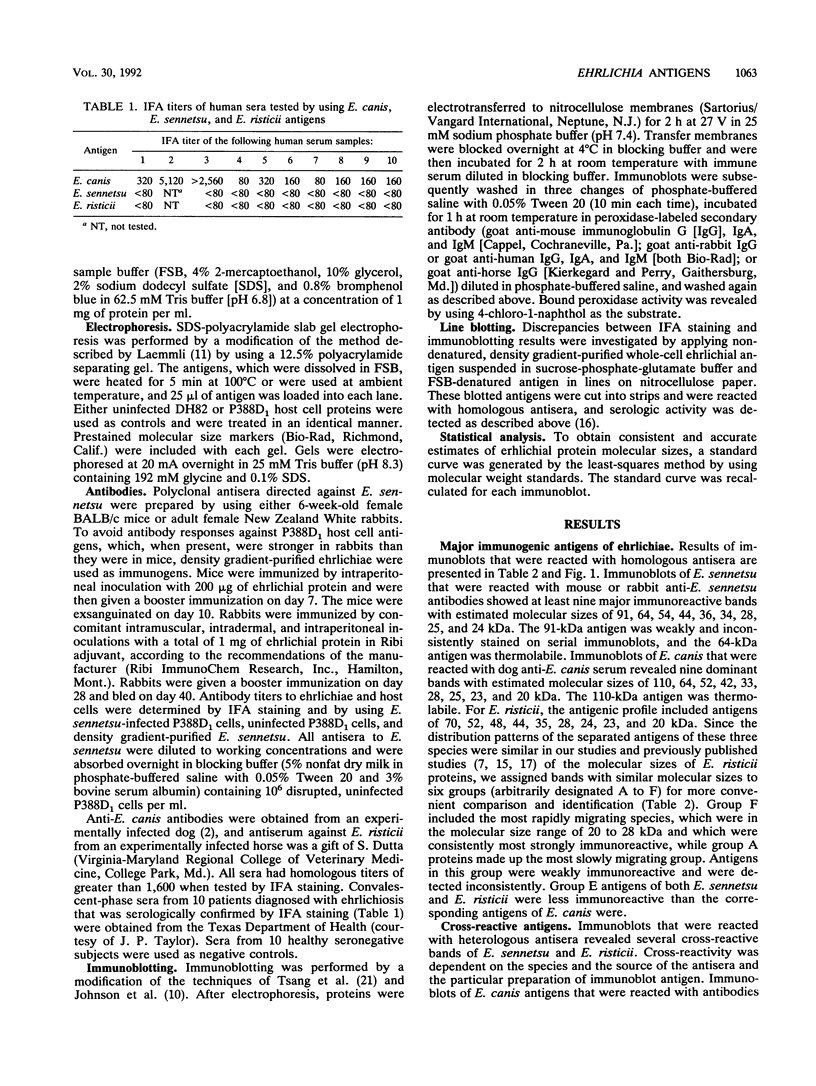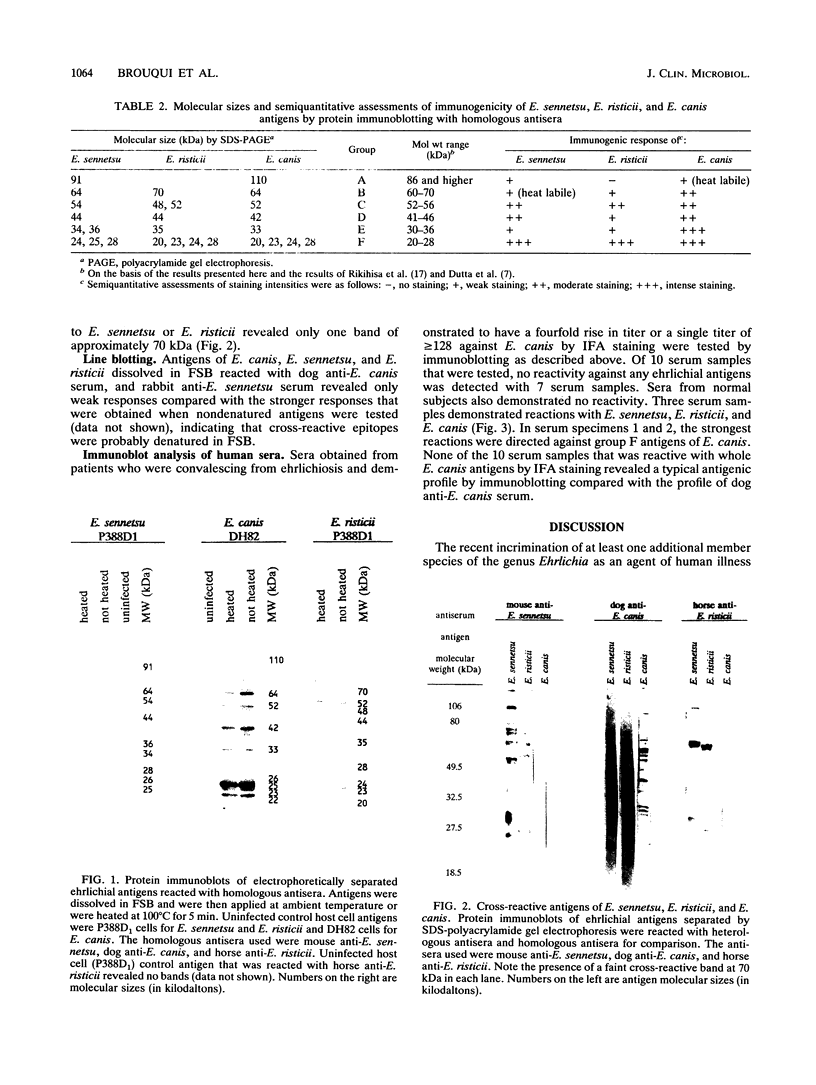Abstract
In recent years a febrile illness apparently associated with tick bite in patients in the United States has been attributed to infection by an Ehrlichia species. This implication is based on serologic responses to E. canis, morphologic demonstration of ehrlichiae in clinical materials, and a single isolate distinct from E. canis which was obtained from a human patient by the Centers for Disease Control. Little is known about the antigens of the ehrlichiae. This report expands the breadth of available knowledge concerning the antigenic components and serologic responses to component antigens of E. canis, E. sennetsu, and E. risticii. Protein immunoblotting after sodium dodecyl sulfate-polyacrylamide gel electrophoresis by using density gradient-purified ehrlichiae and homologous antisera demonstrated reproducible and characteristic antigens within each species (for E. sennetsu, 91, 64, 54, 44, 36, 34, 28, 25, and 24 kDa; for E. risticii, 70, 52, 48, 44, 35, 28, 24, 23, and 20 kDa; for E. canis, 110, 64, 52, 42, 33, 28, 24, 23, and 20 kDa). When antisera were reacted with heterologous antigens, cross-reactivity among these species was virtually restricted to the 70-kDa antigen. Furthermore, when serum samples obtained from 10 patients who were convalescing from ehrlichiosis were tested against each antigen, only three serum samples had any reactivities, and these serum samples reacted with only a few of the antigenic bands. These results documented the molecular sizes of electrophoretically separated antigens of the three Ehrlichia species, confirm their serologic relationships, and support the novel nature of the agent(s) of human ehrlichiosis in the United States.
Full text
PDF




Images in this article
Selected References
These references are in PubMed. This may not be the complete list of references from this article.
- Anderson B. E., Dawson J. E., Jones D. C., Wilson K. H. Ehrlichia chaffeensis, a new species associated with human ehrlichiosis. J Clin Microbiol. 1991 Dec;29(12):2838–2842. doi: 10.1128/jcm.29.12.2838-2842.1991. [DOI] [PMC free article] [PubMed] [Google Scholar]
- Aronson J., Scimeca J., Harris D., Walker D. H. Immunohistologic demonstration of Ehrlichia canis. Ann N Y Acad Sci. 1990;590:148–156. doi: 10.1111/j.1749-6632.1990.tb42217.x. [DOI] [PubMed] [Google Scholar]
- Dasch G. A., Ching W. M., Kim P. Y., Pham H., Stover C. K., Oaks E. V., Dobson M. E., Weiss E. A structural and immunological comparison of rickettsial HSP60 antigens with those of other species. Ann N Y Acad Sci. 1990;590:352–369. doi: 10.1111/j.1749-6632.1990.tb42242.x. [DOI] [PubMed] [Google Scholar]
- Dawson J. E., Anderson B. E., Fishbein D. B., Sanchez J. L., Goldsmith C. S., Wilson K. H., Duntley C. W. Isolation and characterization of an Ehrlichia sp. from a patient diagnosed with human ehrlichiosis. J Clin Microbiol. 1991 Dec;29(12):2741–2745. doi: 10.1128/jcm.29.12.2741-2745.1991. [DOI] [PMC free article] [PubMed] [Google Scholar]
- Dawson J. E., Rikihisa Y., Ewing S. A., Fishbein D. B. Serologic diagnosis of human ehrlichiosis using two Ehrlichia canis isolates. J Infect Dis. 1991 Mar;163(3):564–567. doi: 10.1093/infdis/163.3.564. [DOI] [PubMed] [Google Scholar]
- Dumler J. S., Brouqui P., Aronson J., Taylor J. P., Walker D. H. Identification of Ehrlichia in human tissue. N Engl J Med. 1991 Oct 10;325(15):1109–1110. doi: 10.1056/NEJM199110103251517. [DOI] [PubMed] [Google Scholar]
- Dutta S. K., Shankarappa B., Mattingly-Napier B. L. Molecular cloning and analysis of recombinant major antigens of Ehrlichia risticii. Infect Immun. 1991 Mar;59(3):1162–1169. doi: 10.1128/iai.59.3.1162-1169.1991. [DOI] [PMC free article] [PubMed] [Google Scholar]
- Fishbein D. B., Kemp A., Dawson J. E., Greene N. R., Redus M. A., Fields D. H. Human ehrlichiosis: prospective active surveillance in febrile hospitalized patients. J Infect Dis. 1989 Nov;160(5):803–809. doi: 10.1093/infdis/160.5.803. [DOI] [PubMed] [Google Scholar]
- Laemmli U. K. Cleavage of structural proteins during the assembly of the head of bacteriophage T4. Nature. 1970 Aug 15;227(5259):680–685. doi: 10.1038/227680a0. [DOI] [PubMed] [Google Scholar]
- Maeda K., Markowitz N., Hawley R. C., Ristic M., Cox D., McDade J. E. Human infection with Ehrlichia canis, a leukocytic rickettsia. N Engl J Med. 1987 Apr 2;316(14):853–856. doi: 10.1056/NEJM198704023161406. [DOI] [PubMed] [Google Scholar]
- Morais J. D., Dawson J. E., Greene C., Filipe A. R., Galhardas L. C., Bacellar F. First European case of ehrlichiosis. Lancet. 1991 Sep 7;338(8767):633–634. doi: 10.1016/0140-6736(91)90644-5. [DOI] [PubMed] [Google Scholar]
- Nyindo M., Kakoma I., Hansen R. Antigenic analysis of four species of the genus Ehrlichia by use of protein immunoblot. Am J Vet Res. 1991 Aug;52(8):1225–1230. [PubMed] [Google Scholar]
- Raoult D., Dasch G. A. The line blot: an immunoassay for monoclonal and other antibodies. Its application to the serotyping of gram-negative bacteria. J Immunol Methods. 1989 Dec 20;125(1-2):57–65. doi: 10.1016/0022-1759(89)90078-1. [DOI] [PubMed] [Google Scholar]
- Rikihisa Y., Pretzman C. I., Johnson G. C., Reed S. M., Yamamoto S., Andrews F. Clinical, histopathological, and immunological responses of ponies to Ehrlichia sennetsu and subsequent Ehrlichia risticii challenge. Infect Immun. 1988 Nov;56(11):2960–2966. doi: 10.1128/iai.56.11.2960-2966.1988. [DOI] [PMC free article] [PubMed] [Google Scholar]
- Ristic M., Huxsoll D. L., Tachibana N., Rapmund G. Evidence of a serologic relationship between Ehrlichia canis and Rickettsia sennetsu. Am J Trop Med Hyg. 1981 Nov;30(6):1324–1328. doi: 10.4269/ajtmh.1981.30.1324. [DOI] [PubMed] [Google Scholar]
- Tsang V. C., Peralta J. M., Simons A. R. Enzyme-linked immunoelectrotransfer blot techniques (EITB) for studying the specificities of antigens and antibodies separated by gel electrophoresis. Methods Enzymol. 1983;92:377–391. doi: 10.1016/0076-6879(83)92032-3. [DOI] [PubMed] [Google Scholar]
- Wellman M. L., Krakowka S., Jacobs R. M., Kociba G. J. A macrophage-monocyte cell line from a dog with malignant histiocytosis. In Vitro Cell Dev Biol. 1988 Mar;24(3):223–229. doi: 10.1007/BF02623551. [DOI] [PubMed] [Google Scholar]
- Wright D. G. Human neutrophil degranulation. Methods Enzymol. 1988;162:538–551. doi: 10.1016/0076-6879(88)62102-1. [DOI] [PubMed] [Google Scholar]





